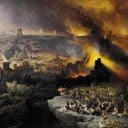As we conclude with our discussion on the Mark of the Beast remember that historically there were physical markings to designate one allegiance. A slave would be marked or pierced to show his allegiance to his master. Cattle is marked to show ownership as well. Roman military members would mark or tattoo themselves representing their legion in order to show allegiance to their commander and to Rome. This concept of allegiance has always been tied to markings and sealings. This should not be forgotten as we venture into these possibilities.
But also remember that marking are Biblically shown to be quite often Spiritual in nature as designated by things like baptism, circumcision and the Lord’s Supper. Though they contain a physical manifestation that “work” that is done is Spiritual. Quite often the marking is known to or visible to God alone.
2 Tim. 2:19 But God’s firm foundation stands, bearing this seal: “The Lord knows those who are his,” and, “Let everyone who names the name of the Lord depart from iniquity.”
Ephes. 1:13 In him you also, when you heard the word of truth, the gospel of your salvation, and believed in him, were sealed with the promised Holy Spirit
But now we will turn our attention the physical manifestations of the mark of the beast to see how the spiritual marking of those that belong to the devil impacted events in first century Rome and Judea. Here are a few ideas that have been postulated.
- During the Roman occupation of Jerusalem only a “citizen” had the right to take part in commerce that used money for exchange for products or services.
- The Roman insignia (eagle) was used as a “credit card” of sorts
- The Roman citizens also placed an image (usually a coin) of the emperor on a band that would be placed around the head or the wrist
The above denotes the concept of citizenship. Because of the rules of citizenship in the Roman Empire one must first vow allegiance to the Emperor as god and supreme ruler. The Christians and many Jews simply refused to do so and citizenship was denied and the act of buying and selling under the Roman auspices was denied as well. Those outside would buy and sell in a black market of sorts, but was limited and did so under very sharp penalties including the penalty of death.
This concept of citizenship also takes a covenantal turn when Jesus is brought before the Jews as their “king.” The response from Jews showed covenantally where their allegiances laid.
John 19:15…The chief priests answered, “We have no king but Caesar.”
This blatant rejection of their covenantal relationship with God and their allegiance with Rome symbolically shows that the seal or mark of God was not on them and therefore the mark of the beast (Rome) was set upon them.
Gary DeMar does a wonderful job arguing for the concept below and I would recommend his book, Last Days Madness, for further exposition.
Also covenantally speaking remember that the buying and selling of worship was controlled by the Jews. Matt 21:12. Those without Roman citizenship were refused entrance into the Temple for worship and sacrifices. The Biblical concept of money and it’s uses are outlined in Isaiah 55 and the Jews who controlled the Temple rejected the Biblical notion and were under the sealing of the beast, not the marking of God. Those who refused this marking were expelled from the temple.
Note even how Jesus predicts this exact thing…
John 16:2 They will put you out of the synagogues. Indeed, the hour is coming when whoever kills you will think he is offering service to God.
Paul even experiences this first hand in Acts 21.
So, whether this marking is covenantal and symbolic or literal and physical, the options above clearly show the possible fulfillment of this during the first century and is connected to the Roman Empire and the Jewish leadership. This ties in with the Olivet Discourse understanding of events as well.
Next we will finish our quick detour into the book of revelation and look at this character known as the Beast from the Land, or the second Beast that promotes the worship of the Beast. It was important, though, that we understood how the first beast and his mark played out as the tie in to the worship of the beast is seen covenantally as well as we will see.





No comments:
Post a Comment